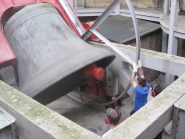Classic FM presenter Laurence Llewelyn Bowen and phenomenal 18-year-old pianist Jan Lisiecki will get up-close and personal with Great George, the famous 9.5 tonne bell in the University of Bristol’s Wills Memorial Building.
The bell will be rung by hand to produce a louder and more pure sound than its automated chime, invoking an emotional and physical response as listeners literally ‘feel the music’ – a theme for the Bristol Proms, which runs from 29 July to 3 August at Bristol Old Vic.
Led by Tom Morris, Artistic Director of Bristol Old Vic and one of Britain’s most celebrated theatre directors, the shows feature performances in the dark, a digital hack and house music played on the cello.
Tom said: “Although it’s inspired by the riotous and popular concerts performed here 200 years ago, Bristol Proms is far from an historical exercise.
“The programme will involve pioneering experiments in digital film and sound. It will be an exploration into how a concert might become theatrical in new ways in the 21st century.”
The opening night includes two simultaneous performances by pianist Jan Lisiecki – one for the audience at the Old Vic, where the historic auditorium will be brought to life with laser beams, and one for a second audience watching remotely at the Watershed which will show an immersive black and white film to experience the intimate details of the performance.
On Friday, audiences will get closer to the music than ever before as violinist Nicola Benedetti MBE, a former BBC Young Musician of the Year, plays a special set accompanied by danceroom Spectroscopy (dS), which will visualise how the energy produced by her playing guides atomic motion.
The brainchild of Dr David Glowacki from the School of Chemistry at Bristol University, dS is a real-time, immersive technology that allows people to see and hear how their own energy fields interact with the matrix of hidden energy fields and atomic dynamics that surround us all. This will be the first time it’s used in the context of classical music, using quantum mechanics to chart the shift in particles around the performer’s body to create a colourful map.
The University of Bristol's Institute for Advanced Studies is hosting an informal panel conversation of the performance the following morning at 11am in the Bristol Old Vic. This event will be a conversation about movement, sound, vibration and dance, inspired by Nicola Benedetti’s recital.
Bristol Old Vic is the oldest working theatre in the country and has been a concert hall and playhouse since its opening in 1766, with a hugely popular series of promenade concerts in the 1840s, featuring Paganini, amongst others.
For the first time since last year's redevelopment, the Theatre will be making use of the recovered standing pit at the front of the stage so audiences can stand on the very same spot as they might have during the 18th century for just £5.
Watch Classic FM's video of Laurence Llewelyn Bowen ringing Great George here.
